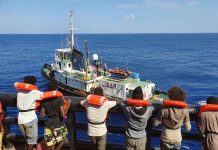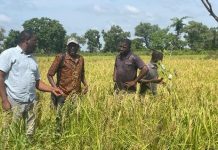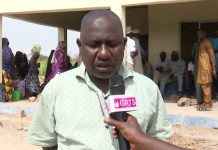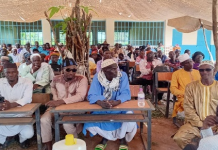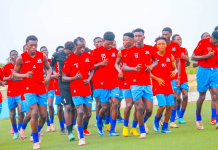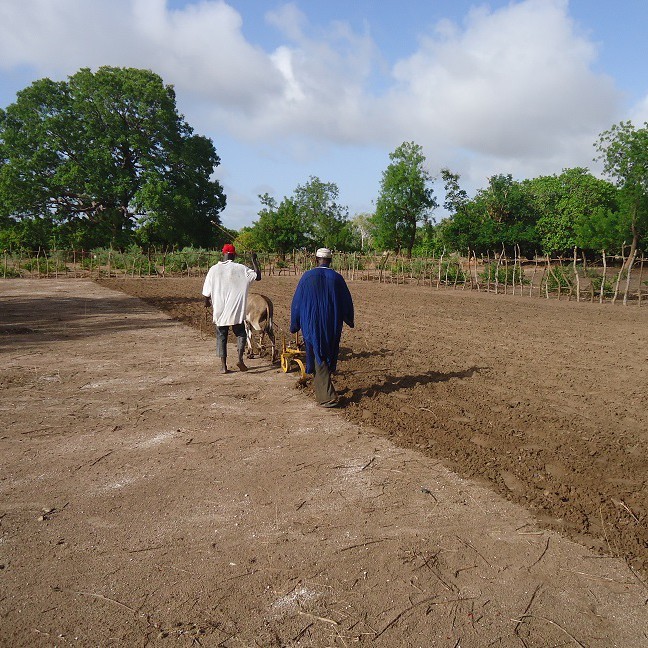By Lamin Fatty, reporting from Basse
As the rains begin to mark their return to the farmlands of The Gambia’s easternmost region, Samba John, the Regional Agricultural Director for the Upper River Region (URR), has issued a cautious but resolute advisory to farmers: be patient, time your planting, and use the seeds wisely.
In an exclusive interview held in his office in Basse, the regional capital, John said his department has entered its critical phase of seasonal preparation. “My name is Samba John, I’m the Regional Agricultural Director, URR,” he began, formally. “This is normal for us, since it’s the beginning of the rainy season. So we are here to assess the preparation of the regional office, as regards to this year’s farming season.”
Early Rains, But Planting Must Wait
According to John, the region has already received three significant rainfalls, with the first arriving near the end of May, measuring around 43.7 millimeters. A second followed two days later, though it was slightly less — under 40 millimeters.
Despite these early showers, John warned against premature planting. “What we advise farmers is that, let them wait,” he said, citing forecasts from the Department of Water Resources and Hydromet. “They said that rain will start — for URR here — around the 12th to the 19th. Those are the planting seasons. So we advise farmers, especially those who want to cultivate groundnuts, let them wait until around that particular period, when they have heavy rain, before they plant.”
John clarified that crops like millet and early millet, being drought-resistant, could be planted earlier, possibly after the second or third rain. But groundnuts, a staple and cash crop in the region, require a more precise timing for optimal yield. “Let them wait for that particular period — before or around the 12th to 19th — when we have heavy rains, they can plant their groundnut,” he emphasized.
To prepare farmers across the region, the agriculture department launched a sensitization campaign through local radio. “We have a radio program at GRTS, whereby we sensitize the farmers, let them clear their fields, and prepare their farm for implementation,” John explained. “That was done every Wednesday at GRTS Radio in Basse.”
The program, he said, encourages early field clearing so that farmers can begin planting immediately after consistent rainfall begins. The focus, he added, is on “letting them know the right time to start planting.”
Seeds, Fertilizers, and Project Support
The start of the rainy season has also kicked off a wide-reaching distribution of seeds, fertilizers, herbicides, pesticides, and even ploughing services. John said the government and several agricultural support projects are working in tandem to support farmers.
“Yes, we are well prepared,” he said. “We have the GAPSI project, the Roost project, the Regional Rice project, and the Giraffe project.”
He explained that GAPSI’s registration of farmers was done during the dry season to estimate seed needs accurately. “Some of their inputs have already arrived and we have started distributing.” For Giraffe, he added, “they brought their rice and maize seeds. We have started the distributions across the regions, because we have different distribution points where the seeds have been deposited. The Extension workers will use the seeds, call the farmers, and those who are interested will pick them up.”
John said the Regional Rice Project went a step further by providing intervention sites with seeds, fertilizers, herbicides, and pesticides — all during the dry season. “So that they can be well prepared. Immediately when the rain starts, they can plant their seeds.”
The Roots Project, which focuses on vegetable production and rice, has also supported its 13 intervention communities with seeds, fertilizers, and ploughing services. The support follows a cost-sharing model: “The community will pay 20%, while the project pays 80%. That is used as a sustainable mechanism so that when the project phases out, the community can continue the initiative, because at least they will have some money in their account.”
Targeting Over 4,000 Farmers
John estimated that over 4,000 farmers are targeted by the combined project efforts. “We are expecting nothing less than 4,000 farmers across all the project intervention areas,” he said. “Some are receiving fertilizers, others ploughing services, some herbicides and pesticides. At least four projects are supporting farmers with inputs.”
This integrated support, he believes, will help strengthen food security across URR, especially after last year’s farming season which saw devastating floods.
Recovering From Flooded Fields
John confirmed that last year’s rainy season was marked by serious flooding that destroyed many rice fields. In response, he said, the ministry and its partners are prioritizing the use of flood-tolerant rice varieties.
“That is why the project came up with these flood-tolerant varieties, especially Sile 210. These are lowland ecologies. We want farmers that want to take this Sile 210 to put it in their lowland areas,” he explained.
For those who lost their crops last year, the Giraffe project stepped in during the dry season to offer free seeds as replacement. “Because last year, most of their fields were flooded, they were not able to have a very good harvest,” John said. “That’s why Giraffe also supported some of these communities — Damfau, Kunda, and Sutukoba, for example — during the dry season.”
He confirmed that both Sile 210 and Nerica L1971 are varieties being recommended for their tolerance to flood conditions. “Even last year we used it, and also this year. But we advise farmers, let them use these varieties in flood-prone areas.”
A Word of Caution: Don’t Waste Seeds
As the interview neared its conclusion, John took a moment to deliver a heartfelt message to farmers: use the seeds responsibly.
“These seeds are very expensive,” he said. “It’s a lot of money. So if you are given a seed, please make sure that you plant it at the right time, at the right place. We don’t want these seeds to be diverted into food consumption. Let them utilise the seeds and plant it. Because that’s the only way we can fight food insecurity.”
John said even a small amount of properly planted seeds could yield significantly larger harvests. “If you use 20 kilos of seeds, you can get more than 20 kilos — even 100 kilos or 2,000 kilos. So I think it is better to use the seeds than to divert them.”
Border Tensions Surface
Just as the conversation was winding down, John was asked about a recent concern emerging from Gambian farmers with farmlands along the Gambia-Senegal border, particularly around Gambisara and Mabula. These farmers, he was told, are now being asked by Senegalese authorities to obtain laissez-passer permits before using Gambian tractors on their cross-border lands.
John said this was the first time he had heard of the issue. “Well, I’m not aware of that,” he replied candidly. “I have never received any farmer complaint about their farm being part of Senegal and they were refused access to use tractors. I’m just hearing this now.”
However, he promised to follow up. “I’ll engage my extension workers. If they receive any information, let them forward it to the main office. But presently, I don’t receive any complaint of that.”
Final Thoughts
With a watchful eye on the sky and his team mobilized across the region, Samba John is determined to make this rainy season more productive than the last. His advice remains clear and firm: wait for the right rains, plant at the right time, and use the seeds for planting — not for food. It is a message grounded in the region’s vulnerability to climate shifts, but also in its enduring potential.
“That’s the only way we can fight food insecurity,” he repeated. “That’s the only way.”

